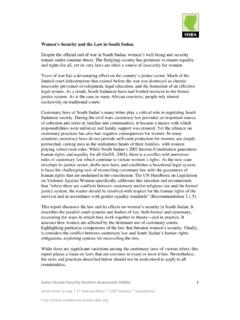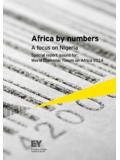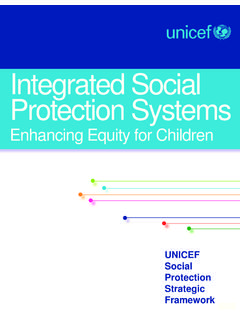Transcription of ISOLATION AND ENDURANCE - HSBA Project
1 Riek Machar and the SPLM-IO in 2016 17 John YoungISOLATION AND ENDURANCEA publication of the Small Arms Survey s Human Security Baseline Assessment for Sudan and South Sudan Project with support from the US Department of StateHSBA2 Report October 2017 young ISOLATION and ENDURANCE 3 Published in Switzerland by the Small Arms Survey Small Arms Survey, Graduate Institute of International and Development Studies, Geneva, 2017 First published in October 2017 All rights reserved. No part of this publication may be reproduced, stored in a retrieval system, or transmitted, in any form or by any means, without prior permission in writing of the Small Arms Survey, or as expressly permitted by law, or under terms agreed with the appropriate reprograph-ics rights organization.
2 Enquiries concerning reproduction outside the scope of the above should be sent to the Publications Manager, Small Arms Survey, at the address Arms Survey Graduate Institute of International and Development Studies Maison de la Paix, Chemin Eug ne-Rigot 2E1202 Geneva, SwitzerlandEditor: Emile LeBrun by Alex Potter by Donald Strachan in Meta by Rick Jones by nbmedia in Geneva, SwitzerlandISBN 978-2-940548-41-5 CopyrightCover photo: Sudan people s Liberation Movement-in-Opposition (SPLM-IO) rebels outside the town of Kaya, South Sudan, on the border with Uganda, after an assault on Sudan people s Liberation Army (Sudan people s Liberation Army) soldiers. REUTERS/Goran Tomasevic young ISOLATION and ENDURANCE 3 About the authorJohn young is a Canadian with a PhD in political science who has worked in the Horn of Africa since 1986 as a teacher, journalist, peace monitor, consultant, and academic.
3 He has published two books, Peasant Revolution in ethiopia : Tigray people s Liberation Front 1975 to 1991 (Cambridge University Press, 1997) and The Fate of Sudan: Origins and Consequences of a Flawed Peace Process (Zed Books, 2012), as well as numerous articles on regional conflicts, peace processes, and Report October 2017 young ISOLATION and ENDURANCE 5 Acknowledgements The author wishes to acknowledge the help of Bol Gatkouth, former SSDF spokesperson and GRSS Member of ISOLATION and ENDURANCE 5 The HSBA projectThe Human Security Baseline Assessment (HSBA) for Sudan and South Sudan is a multi- year Project administered by the Small Arms Survey. It was developed in cooperation with the Canadian government, the United Nations Mission in Sudan, the United Nations Development Programme, and a wide array of international and Sudanese partners.
4 Through the active generation and dissemination of timely, empirical research, the pro-ject supports violence reduction initiatives, including disarmament, demobilization, and reintegration programmes, incentive schemes for civilian arms collection, as well as security sector reform and arms control interventions across Sudan and South Sudan. The HSBA also offers policy-relevant advice on redressing insecurity. All publications are available in English and Arabic at: The HSBA receives direct financial support from the US Department of State. It has received support in the past from the Global Peace and Security Fund at Foreign Affairs and International Trade Canada, the Ministry of Foreign Affairs of Denmark, the Nether-lands Ministry of Foreign Affairs, the Norwegian Ministry of Foreign Affairs, and the UK government s Global Conflict Prevention Pool, as well as from the Danish Demining Group, the National Endowment for Democracy (US), and United States Institute of Peace.
5 The Small Arms Survey also receives Swiss funding, without which the HSBA could not be undertaken effectively. For more information or to provide feedback, please contact: Khristopher Carlson, HSBA Project Coordinator Human Security Baseline Assessment for Sudan and South Sudan Small Arms Survey, Maison de la PaixChemin Eug ne-Rigot 2E, 1202 Geneva Switzerland t +41 22 908 5777 f +41 22 732 2738 e Report October 2017 young ISOLATION and ENDURANCE 7 List of abbreviations and acronyms .. 7 Introduction .. 9 Key findings .. 12 Machar s reluctant return to Juba .. 15 The SPLM-IO and Machar in Juba .. 21 Crowning Taban Deng as first vice president and marginalizing Machar .. 27 Organization of power in the SPLM-IO .. 35 SPLM-IO relations with other opposition parties.
6 41 Prospects of opposition unity .. 45 Conclusion .. 49 Endnotes .. 52 References .. 54 ContentsYoung ISOLATION and ENDURANCE 7 List of abbreviations and acronymsARCSS Agreement for the Resolution of the Conflict in the Republic of South SudanAU African Union CPA Comprehensive Peace AgreementCTSAMM Ceasefire and Transitional and Security Arrangements Monitoring Mechanism DRC Democratic Republic of the CongoFD Former DetaineesFDP Federal Democratic PartyFVP First vice presidentIDP Internally displaced personIGAD Intergovernmental Authority on Development JIP Joint Integrated PoliceJMEC Joint Monitoring and Evaluation Commission NDM National Democratic MovementNGO Non-governmental organizationNSF National Salvation Front PDM people s Democratic MovementPoC Protection of civiliansSPLM/A
7 Sudan people s Liberation Movement/Army SPLM-IO Sudan people s Liberation Movement-in-Opposition SSDF South Sudan Defence Forces TGoNU Transitional Government of National UnityUN United NationsUNMISS UN Mission in the Republic of South Sudan8 Report October 2017 young ISOLATION and ENDURANCE 9 young ISOLATION and ENDURANCE 9 Introduction .. fighting has continued and spread, the humanitarian crisis has deepened, and the international peacemakers are reduced to making appeals to end the violence that are ignored. 10 Report October 2017 young ISOLATION and ENDURANCE 11 Hopes that the August 2015 peace agreement between the Sudan people s Liberation Movement (SPLM) government of Salva Kiir and the Sudan people s Liberation Movement-in-Opposition (SPLM-IO) of Riek Machar would end the conflict in South Sudan collapsed with the return to fighting on 8 July 2016.
8 A year later the fighting has continued and spread, the humanitarian crisis has deepened, and the international peacemakers are reduced to making appeals to end the violence that are Sudan experienced a series of wars that began with Sudan s independence in 1956 and with a break between 1972 and 1983 continued until 2005. The region first gained international attention because of these wars and a series of humanitarian dis-asters. With no end in sight to the conflict, a group of Western countries led by the United States encouraged the Intergovernmental Authority on Development (IGAD) to mediate the conflict, and Britain, Norway, and the United States formed themselves into a Troika to support these efforts. The mediators concluded that the primary cause of the conflict was the disparity between an Arab Islamist regime in the north and the disenfranchised polyglot of Africans in the south, and that southern self-determination and ultimately secession and the handing over of state power to an SPLM government would both end the conflict and provide a basis for resolving other armed struggles afflicting Sudan.
9 But the 2005 Comprehensive Peace Agreement (CPA) that gave birth to South Sudan in July 2011 did not bring peace and stability to either Sudan or South Sudan, and it became increasingly apparent that the SPLM could neither resolve its own internal problems peacefully nor effectively administer the country. The outbreak of civil war in December 2013 was not a surprise, only the form it took of a government-orchestrated attack on Nuer civilians, and once again IGAD and the Troika launched a peace process. And like the one that led to the signing of the CPA, it focused on power-sharing and security arrangements, this time between the SPLM factions that had monopolized power in the country. When the peace process collapsed in March 2015 an expanded international mediation (IGAD-Plus) was created that produced an agreement in August 2015, the Agreement for the Resolution of the Conflict in the Republic of South Sudan (ARCSS) (IGAD, 2015).
10 It was considered to have been forced on the parties because President Kiir made clear he only signed the agreement because of enormous interna-tional pressure and his government disagreed with critical parts of it. Meanwhile, after suffering a string of military defeats, the defection of many of its senior military com-manders, and a lack of military logistics, the SPLM-IO readily endorsed the ARCSS ( young , 2015). Few were optimistic that the agreement would survive, however, and indeed it merely served as a stimulus for increased armed conflict in many areas of the country. Although the government failed to implement key provisions of the ARCSS, including the security arrangements, the international backers of the peace agreement insisted that a reluctant Machar return to Juba and assume his position as first vice president young ISOLATION and ENDURANCE 11(FVP) in the Transitional Government of National Unity (TGoNU).








